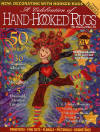
Article # 2
Visit Peggy's Home!
A Celebration of
Hand-Hooked Rugs XIV
2004
Edition |
 |
| |
|
|
RIGHT: The
flagstone-lined, foyer
of Peggy's home is a
gallery of her hooked
rugs, cherished family
photographs, and
eclectic pieces of art
she and her husband both
inherited and collected. The central focus is Lurcat, a 43" x 71" Jane McGown Flynn design
hooked in deep, rich
tones. Hanging nearby is
Unicorn in Captivity, a
classic Pearl McGown
design that she
completed in 1999, and
presented to her husband
as a gift on their 50th
anniversary. "I had done
the unicorn and part of
the fence, then put it
away," she said. "Then I
decided to finish it for
my husband, and found
that I actually enjoyed
hooking all those picky
little flowers."
In the foreground is the Gainesborough rug, which provides a
colorful focal point in
a living room awash in
muted colors.
|
|
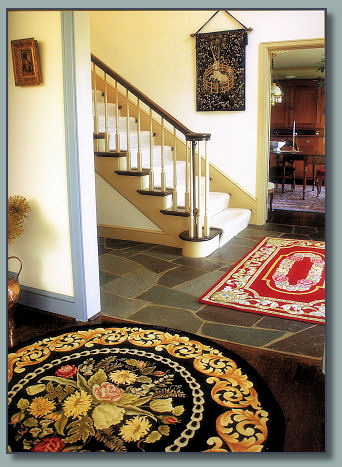 |
|
|
Margaret (Peggy) Haller Hannum considers herself an
inveterate and uniquely experienced nest-featherer.
The award-winning rug hooker has moved her family
in and out of 12 homes over the course of her 52-year marriage as
her husband, an United Methodist minister, earned his degrees and
was reassigned to different parishes.
Each time, Peggy worked with different decorating constraints,
but managed to find welcome homes for most—if not all—of the
nearly 25 rugs she's hooked since she discovered the craft roughly
25 years ago.
"I planned just about each one with a particular spot in mind,"
said Peggy, a retired English teacher. "But no matter where I put
them, they always seem to work."
When discussing her decorating technique, Peggy fails to take
credit for her keen eye for combining pattern, colors, and contrasting
textures within her center hall colonial-style home in Pennsylvania.
Room after room offers up artful displays of treasured family antiques,
and items of interest culled from a lifetime of travel.
Still, she noted, her finely honed skill was borne of necessity.
"As a minister's wife, I was used to having to move from one
Methodist parsonage to another," she said. "They usually weren't
furnished. We were always fortunate to have some furniture we
inherited, but I'd go in and make drapes, or do whatever I could to
make them homey and warm."
While she and her husband, Bob, were raising their three chil-
dren and Peggy was teaching school, she still managed to find a
few quiet hours each evening for hooking, and found that she
could complete beautiful, meaningful pieces that suited her home.
Peggy discovered rug hooking after trying her hand—and mastering—several other forms of creative expression. After completing
several quilts, knitting well over a hundred sweaters, creating botanical drawings with pastels, pleating lampshades, and sewing virtually
all of the window treatments, slipcovers, and bedspreads for her family's succession of homes, Peggy was encouraged to try rug hooking.
"My dear friend, Lyn Lovell, used to knit with me when we
would all go on family ski vacations," she said. "One night, when
we were in Killington, Vermont, she pulled out a
project she was working on and said, 'I have
something you're going to love.' |
I
thought, 'I can't do one more thing,' but I tried it." She took on a
small project—a hooked doorstop in a pansy pattern. "No shading,
very unsophisticated—almost paint-by-number," she recalled. "But
by the end of the week, I was hooked."
When she returned from vacation, Peggy ordered a catalog from
the Heirloom Rug Company, and found herself captivated by it. "It
was like a wish book," she said. "I couldn't wait to get started, so I
called a local school, Essex Agricultural, and went to see the
teacher of a class that had already started. That's how I met
Meredith LeBeau, who was a wonderful, very encouraging mentor."
Meredith wanted her enthusiastic new student to start with a
small project, but Peggy had already zeroed in on an iris-patterned
rug that she was determined to bring to life. Soon she was well
along on Irises, which measures 38" x 54" and currently resides in
her bedroom. "I still love that rug," she says- "And I still use it. It's
faded, but faded nicely."
Since that time, Peggy has perfected her skills to the point where
she adapts or creates her own designs, attends
regular workshops on hooking and dyeing, and
teaches students in the basement workshop of her home.
She's also become more prolific. When she started hooking in
1977, a rug might have taken years to complete. Now, by devoting
a few hours each evening, she can complete as many as three rugs
a year. Peggy primarily uses a #3 -cut, which she found makes the
work go much faster. "I don't have to hook as high," she said.
Her award-winning work, which has been featured several times
in previous issues of Rug Hooking Magazine, continues to be
inspired by teachers such as Nancy Blood of Oswego, N.Y., and
Meredith. "I've been with Nancy in class after class for the past six
years," said Peggy. "And through her unique ability, she's guided
me over new horizons with color and technique. I've found that
there is still so much out there to learn from other people. I've been fortunate to have such wonderful friends and mentors."
Also evolving is her decorative style, which deftly combines old
and new, traditional and obscure. Her words of advice for others
hoping to do the same? "Trust your taste," she said. "Surround
yourself with the things that you truly love. It will all go together."
|
|
|
 |
LEFT: Peggy's
award-winning Queen Mary, a rug designed
by Jane McGown Flynn, which measures 38" x 72",
provides a welcome burst of color in a muted
guest room. The nineteenth century walnut
bed, Peggy notes, "was considered an antique
when I was just a little girl." On
the rocking chair are antique dolls-- one that
Peggy received from her grandmother. Other
accents come from a pastel created by Peggy of a
lily and delphinium from her garden, and a
scattering of delicately toned antique plates.
|
|
RIGHT:
Peggy's
Gainsborough, is a 60" round
Pearl McGown design that she completed in 1983.
Although it was originally designed for an
earlier Federal-style home in Massachusetts,
Peggy feels that its classic floral-and-scroll
design adapts well to traditional furniture such
as her antique corner cabinet and
side
table.
|
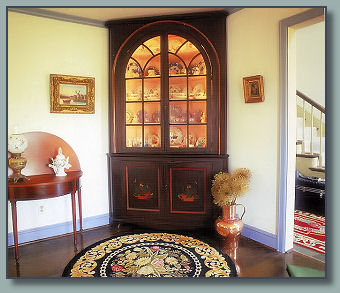 |
|
She also
offers the following:
DON'T
BE OVERLY CONCERNED WITH "MATCHING"
SPECIFIC RUGS TO SPECIFIC COLORS,
PATTERNS OR PIECES OF FURNITURE.
Peggy pairs such seeming disparate
items as Lancaster County family
heirlooms, Staffordshire china,
formal silver pieces, brass and
copper vessels from the Mideast,
Burmese tapestries, Armenian tiles,
Palestinian needlework, and
cherished dolls from her childhood.
"Somehow," she said, "it all works."
EXPERIMENT.
"All sorts of colors and patterns
work well together, even if you
can't envision them," said Peggy.
"Colors may complement each other in
a way that you can't anticipate. The
only way to find out is to move them
around, and see what works with
what. "I used to make rugs for
specific areas, especially when we
lived in our home in Massachusetts,
but I've stopped doing that. Now I
want to play with the colors, not
really thinking of where it has to
go." In her family room, for
example, the soft, autumnal tones of
her Wildwood rug suit the warm,
traditional setting. But eventually,
she said, it might be replaced by
Istanbul, which is characterized
with more vivid colors and higher
contrast. "I'm sure it will work
fine," she said. "The beauty of
hooked rugs is that they adapt so
well to their surroundings."
SHOWCASE
RUGS BY TONING DOWN THE BACKDROP.
Instead of layering pattern on top
of pattern, Peggy likes to keep
walls, floors, and window treatments
fairly neutral. "That way," she
said, "the rugs don't have to
compete for attention."
MAKE THEM
A PART OF YOUR DAILY LIFE.
With the exception of a large piece
titled Silver Compote, which hangs
in her dining room, and Unicorn in
Captivity, which graces the foyer,
most of Peggy's rugs remain
underfoot. "Rugs are rugs," she
says. "You have to walk on them. I
let my grandchildren play on them in
the family room, and I have only one
rule: Food stays in the kitchen.
Other than that, the rugs are there
to use and to enjoy and appreciate
every day."
LOOK TO
THE COLORS AND PATTERNS IN A ROOM
FOR INSPIRATION AND A RUG TO
COMPLEMENT THEM.
Peggy said that when she originally
began hooking rugs to fill her
homes, she often looked to the
distinctive shade of blue on
existing wainscoting, or a prominent
color in a floral pattern on the
wallpaper. "Or, take your cue from
one of your nicer pieces--maybe a
quilt that has special significance
or meaning, or a pattern on a chair
you've always loved," said Peggy.
"They'll point you in the right
direction. Just don't be too
confined by them."
EMBRACE
THE UNIQUE, ALBEIT IMPERFECT,
ASPECTS OF HANDMADE ITEMS.
Even an accomplished and experienced
rug hooker as Peggy can see the
progress in her work as she becomes
more daring in color, develops a
more sophisticated eye for pattern,
or hones her tastes. But, as with
many items in her home, each rug
holds special significance and is
given a worthy presentation. "Each
one has its own little story to tell
or has so many special memories
associated with it," said Peggy.
"Each one reminds me of a part of
our lives, or our children's lives,
or the homes we lived in. That's the
joy of having them and using them."
•
|
|
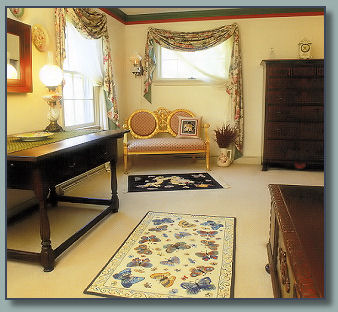 |
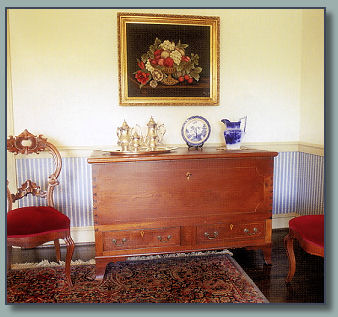 |
|
ABOVE:
Peggy's Chinese Butterflies, a Jane McGown Flynn design measuring 48" x3l", which was featured in A Celebration of Hand-Hooked Rugs XI," was selected by the 2000 National Guild of Pearl K. McGown
Hookcrafters
to be featured on notecards. In Peggy's master bedroom, it shares space with Manchu Dragon, a 31" x 49" Jane McGown Flynn design that Peggy adapted. It was inspired, she says, by Norbert, the fierce but friendly dragon from the Harry Potter series. Nearby is a gold-washed settee, an early Pennsylvania walnut stretcher table topped with a silk runner from Burma, her mother's Lane hope chest, and a collection of antique floral plates. |
ABOVE:
Peggy's Silver Compote, which was featured in A Celebration of Hand-Hooked Rugs XII, measures 27" x 23", and was designed by Charlotte Stratton. It is given a prominent place in the Hannum dining room, where a muse- um-quality treatment complements the formality of antique silver tea service and cobalt-blue Staffordshire pieces atop an antique Pennsylvania blanket chest.
|
|
|
RIGHT: Peggy Hannum admits that she was
probably initially attracted to this 7' x 4' rug
based on its name, Salem, and originally
planned to use this in an upstairs hallway in the
couple's Federal-style home in Massachusetts.
She began it in 1993, using all white wools that
she dyed with colors supplied by her teacher,
Meredith LeBeau, and finished it 11 years
later.
"One of the things Meredith taught me was
to always dye enough wool for an entire project, and to keep very, very good notes," says
Peggy. "1 followed her advice and kept meticulous notes, so I was able to match the colors
exactly when 1 picked the rug up again years
later."
The rug takes center stage in a guest bed-
room furnished with family antiques, such as a
Victorian bed from her grandmother's guest-
room, a marble-topped pedestal table, a
Lancaster County crazy quilt her grandmother
gave her when she married, and a
Pennsylvania-style ladder back chair. On the
bed is a quilt Peggy purchased more than 40
years ago from a Pennsylvania quilter. |
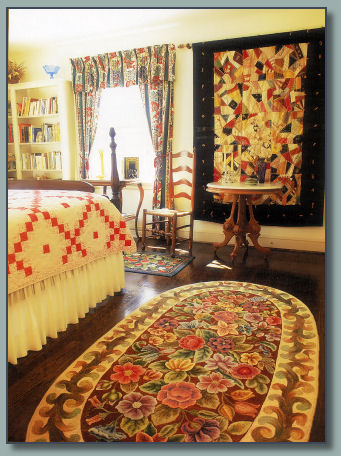 |
|
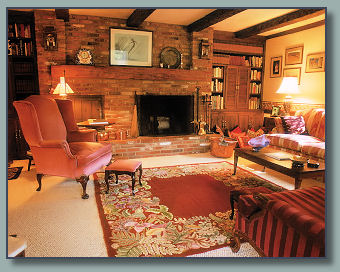 |
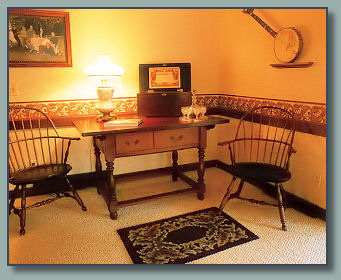 |
|
ABOVE:
One of the largest rugs in the
Hannum home, the 7' x7'
Wildwood design from Heirloom Rugs, echoes the warm tones of the brick
hearth in the family room, and complements the
copper pieces and other treasures the couple
brought home from their time spent in the Middle
East.
|
ABOVE:
In a corner of the family room,
an heirloom tavern table, antique music box,
banjo and family portrait are accompanied
by Peggy's Oak Scrollings rug. The 23" x
36" rug is a Jane McGown Flynn design.
that Peggy completed in 2002 after being
inspired by tapestries she and her husband
viewed in a museum in Naples. |
|
|
 |
LEFT:
In the living room, the
Pearl McGown
Ming design was
hooked on a 56" by 34" rug in 2001,
and sits before her father's antique
Pennsylvania walnut desk in a quiet
corner. Its Asian flavor provides a
contrast to the traditional elegance of
the formal room.
|
|
|
|
|

